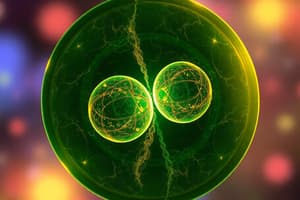Podcast
Questions and Answers
What is the primary function of mitosis?
What is the primary function of mitosis?
- Increasing genetic diversity
- Growth, repair, and asexual reproduction (correct)
- Production of gametes for sexual reproduction
- Production of haploid daughter cells
What is the main difference between mitosis and meiosis?
What is the main difference between mitosis and meiosis?
- Number of cell divisions
- Number of daughter cells produced
- Number of chromosomes in daughter cells (correct)
- Location where cell division occurs
What is the importance of DNA replication in cell division?
What is the importance of DNA replication in cell division?
- Allows for crossing-over to occur
- Ensures each daughter cell has an identical set of chromosomes (correct)
- Increases genetic diversity
- Regulates cell growth and repair
What is the function of mRNA?
What is the function of mRNA?
What is crossing-over, and what is its importance?
What is crossing-over, and what is its importance?
What is the number of chromosomes in a human cell?
What is the number of chromosomes in a human cell?
What is the purpose of meiosis?
What is the purpose of meiosis?
What is the relationship between DNA, chromosomes, and genes?
What is the relationship between DNA, chromosomes, and genes?
What is the primary function of ribosomal RNA (rRNA)?
What is the primary function of ribosomal RNA (rRNA)?
What is the result of a mutation in DNA?
What is the result of a mutation in DNA?
What is the purpose of transcription?
What is the purpose of transcription?
What is the importance of replication?
What is the importance of replication?
What is the relationship between sickle cell anemia and malaria?
What is the relationship between sickle cell anemia and malaria?
What is the result of nondisjunction during meiosis?
What is the result of nondisjunction during meiosis?
What is the purpose of Punnett squares?
What is the purpose of Punnett squares?
What is the term for the physical expression of the genotype?
What is the term for the physical expression of the genotype?
Study Notes
Cell Division
- Mitosis: cell division resulting in two identical daughter cells with the same number of chromosomes as the parent cell
- Meiosis: cell division producing four non-identical daughter cells, each with half the chromosome number of the parent cell
Mitosis and Meiosis Comparison
- Mitosis: growth, repair, and asexual reproduction; produces two diploid (2n) daughter cells
- Meiosis: production of gametes (sperm and egg cells) for sexual reproduction; produces four haploid (n) daughter cells
Importance of DNA Replication
- Ensures each daughter cell has an identical set of chromosomes (mitosis) or the correct number of chromosomes (meiosis)
Human Chromosome Number
- 46 chromosomes (23 pairs)
Crossing-Over and Gene Shuffling
- Crossing-over: exchange of genetic material between homologous chromosomes during prophase I of meiosis
- Gene shuffling: random distribution of chromosomes during meiosis and crossing-over; contributes to genetic variation in offspring
DNA Structure and Function
- Double helix structure made of nucleotides (sugar, phosphate, and nitrogenous base)
- Functions as the blueprint for all genetic information
Relationship Between DNA, Chromosomes, and Genes
- DNA is organized into chromosomes
- Genes are segments of DNA that code for proteins
DNA and Proteins
- DNA contains instructions to make proteins, which are essential for cellular functions
Types of RNA and Functions
- mRNA: messenger RNA, carries genetic information from DNA to ribosomes
- tRNA: transfer RNA, brings amino acids to ribosomes during protein synthesis
- rRNA: ribosomal RNA, makes up the ribosomes
DNA, Proteins, and Mutations
- Mutations in DNA can lead to changes in protein structure and function, potentially causing genetic diseases
Replication, Transcription, and Translation
- Replication: process of copying DNA before cell division; ensures each new cell has a complete set of DNA
- Transcription: process of synthesizing RNA from DNA; produces mRNA for protein synthesis
- Translation: process of assembling proteins from mRNA; converts genetic information into functional proteins
Base Pairing Rules
- DNA: Adenine (A) pairs with Thymine (T), Cytosine (C) pairs with Guanine (G)
- RNA: Adenine (A) pairs with Uracil (U), Cytosine (C) pairs with Guanine (G)
Genetics
Mendel’s Experiments and Punnett Squares
- Mendel’s experiments: studied inheritance patterns in pea plants
- Punnett Squares: tool to predict the probability of offspring traits
Traits and Genotypes
- Dominant and recessive traits: dominant traits mask recessive traits
- Genotype and phenotype: genotype is the genetic makeup, phenotype is the physical expression of the genotype
- Homozygous and heterozygous genotypes: homozygous has two identical alleles, heterozygous has two different alleles
Modes of Inheritance
- Dominance, codominance, incomplete dominance, multiple alleles, polygenic traits, X-linked traits
Nondisjunction
- Failure of chromosomes to separate properly during meiosis; causes genetic disorders like Down, Klinefelter, and Turner syndromes
Sickle Cell Anemia and Malaria
- Relationship between genetic mutation (sickle cell) and resistance to malaria
Evolution
Graphs and Diagrams
- Interpret evolutionary trends and data
Artificial Selection
- Human-driven breeding to select for desired traits
Common Descent and Embryology
- Similar embryonic stages indicate common ancestry
Biomolecular Comparisons
- Comparing DNA/protein sequences to determine evolutionary relationships
Studying That Suits You
Use AI to generate personalized quizzes and flashcards to suit your learning preferences.
Description
Compare and contrast mitosis and meiosis, including identifying stages in diagrams. Learn about the differences between these two types of cell division.




